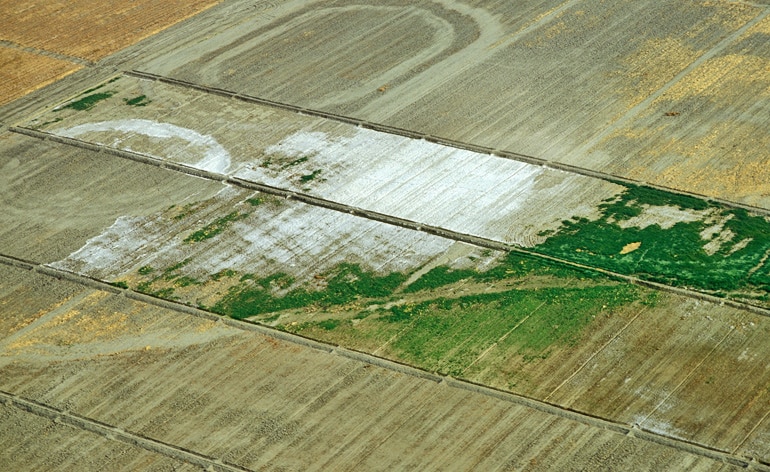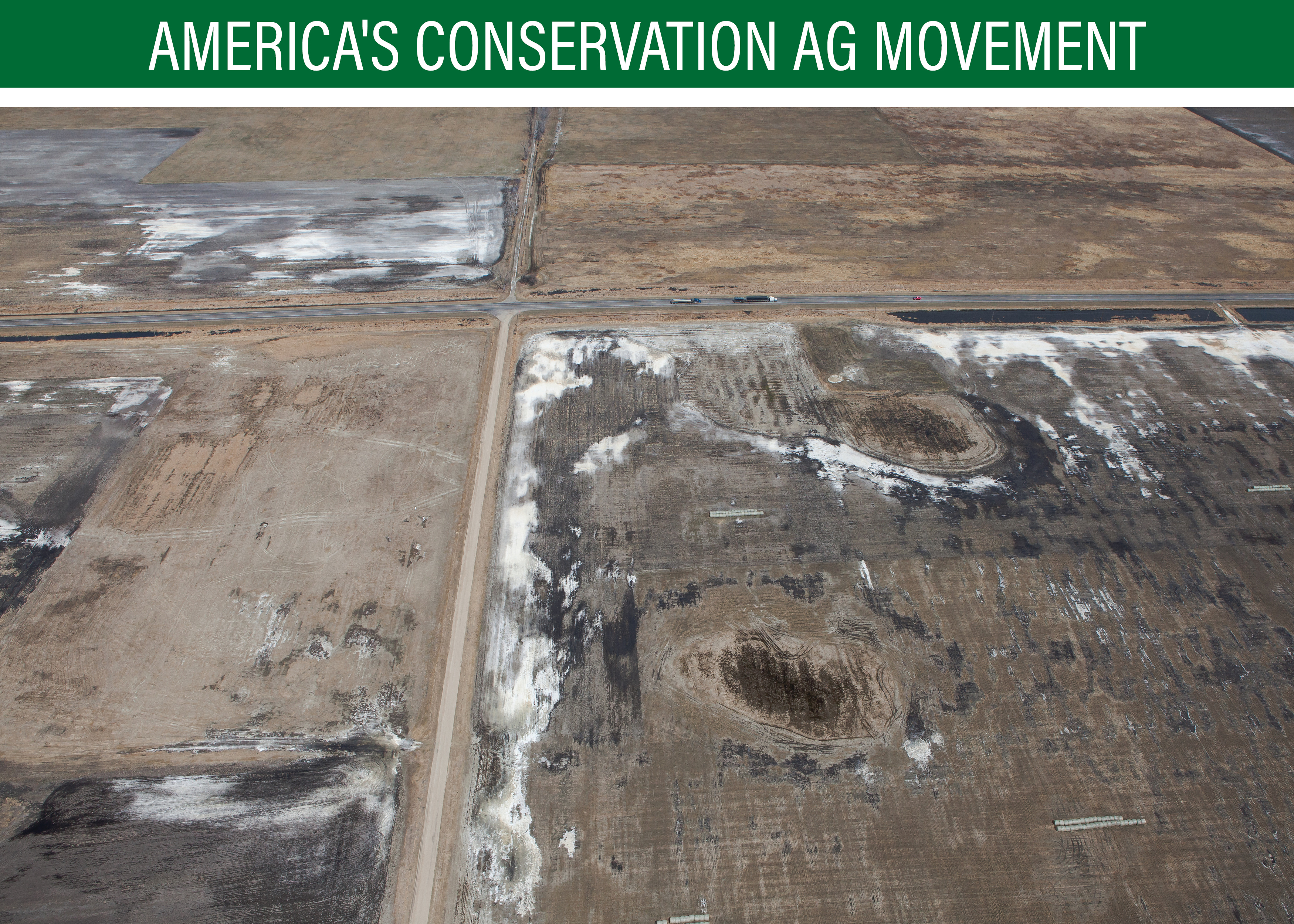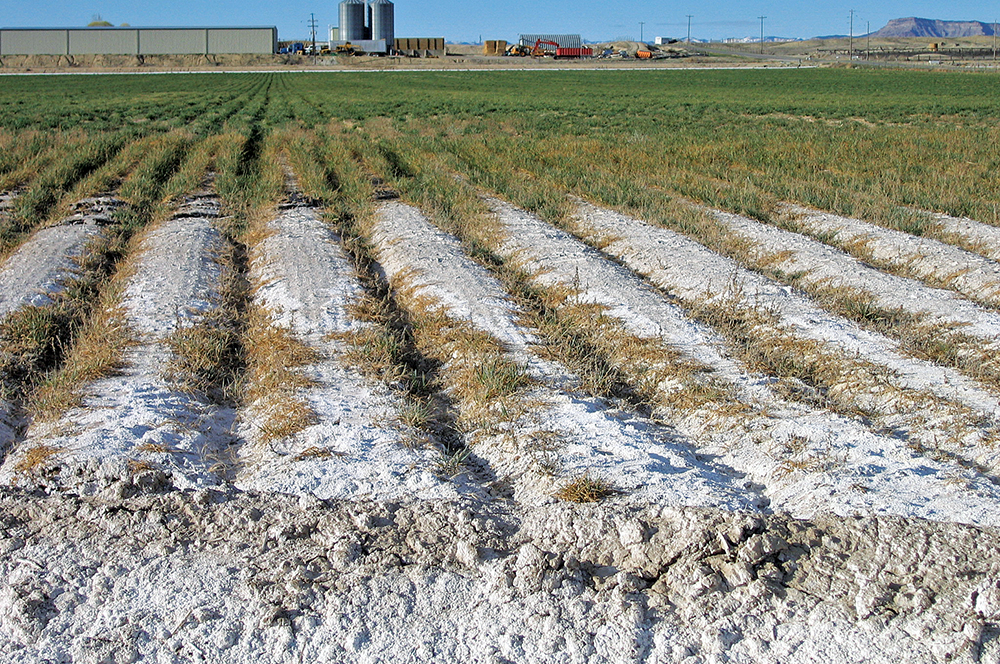The white areas in this North Dakota field are not snow — they are areas with high salinity, which can ultimately cause low crop yields.
Farming requires a high tolerance for dancing with nature. That’s especially true for North Dakota producers such as Mark Cheatley. In places, his soil poses a particular challenge: sodicity creating chemical reactions that, over a long period of time, make soil layers dense, slow down soil water movement, limit root penetration and, ultimately, hurt yield. “On our farm, sodicity started showing up around permanent wet areas,” Cheatley explains. “We started to see reduced productivity in these ‘rings of death.’ What once was our most productive land struggles to grow anything.”
Why Salt Shows Up

Salts and sodium generally make their way into soil from parent material (what soil is formed from) and groundwater discharge, explains Tom DeSutter, professor of soil science at North Dakota State University (NDSU). In the northeastern part of the state, salts come from shale and the upwelling of water from the Dakota Formation aquifer. In southwestern North Dakota, they are predominantly from sedimentary materials.
“When a soil has too much sodium and overall salt content, the soil’s clay particles repel each other,” DeSutter says. “In natural settings, over a long period of time the dispersed clay particles move down the soil profile and creates columnar structure that can be difficult for plant roots to penetrate. Thus, the soil is not very productive.” These soils often have low trafficability when wet. Then they become quite hard when dry.
To address these challenges, Cheatley has partnered with NDSU Extension to remediate soils by incorporating flue gas desulfurization gypsum. He wants to tackle the 5% to 15% of a quarter’s tillable acres where nothing grows. “The problem is getting worse, and I am looking forward to seeing gypsum reverse the trend,” he says.
Gypsum is a byproduct of coal-fired plants in western North Dakota. When incorporated into the soil, a series of chemical reactions occurs in which calcium “acts like a bridge between soil particles and promotes chemical aggregation,” explains Naeem Kalwar, a soil health specialist with NDSU Extension, who has been helping Cheatley remediate challenging soils. “That results in improved soil structure, pore space and water infiltration — just to name a few benefits.”
How Gypsum Helps
The use of gypsum, along with other soil health practices such as cover crops, is intended to help combat sodic soils and also promote overall soil health. The efforts have the potential to save farmers in the region millions of dollars, especially in production of the most at-risk crops such as soybeans, corn, spring wheat and canola, Kalwar says. He’s clear it will take years for Cheatley and his neighbors to see the benefits of the products and conservation practices they are adopting.
On Cheatley’s farm, Kalwar recommended applying 7 to 10 tons of gypsum per acre. Cheatley purchased a Chandler litter spreader for use on sodic areas and buys gypsum for about $4 per ton from a plant in Stanton, N.D. The product has “the consistency of damp flour and does not spread well out of normal fertilizer equipment,” Cheatley notes. Once the product is applied, it is worked into the soil.
Methods To Ease Sodicity
Other practices meant to mitigate sodicity are under evaluation at NDSU Extension. Among them is planting perennial salt-tolerant grasses in areas where annual crops simply won’t grow. Farmers can save between $82 and $187 per acre for not planting crops here, Kalwar says. Although producers must pay upfront costs for the grasses, they will grow back on their own in subsequent seasons.
“By providing a good vegetative cover above the ground, perennial grasses will reduce evaporation, whereas, growing roots will help lower groundwater depths and minimize capillary rise,” Kalwar points out. “Farmers can mow, hay or graze these grasses and can actually earn some income rather than only losing money on the problem acres. If cut at the right times, these grasses are fair to good hay.”

How to Improve Productivity in Saline and Sodic Soils
Nearly 15% of cropland in North Dakota has reduced productivity due to soil salinity and sodicity issues, per North Dakota State University. These tips can counteract this challenge.
- Sample soils to determine the salt and sodicity levels. If sodicity is established, consider applying a soil amendment such as gypsum.
- Plant crops tolerant to the salt values present. This might include seeding a cover crop following a small grain or other short-season crops.
- If salt levels are too high for crops such as barley and oats, consider planting perennial salt-tolerant grasses.
- Monitor the salinity levels annually to see progress.
- Establish an alfalfa buffer strip next to a ditch that is the source of salinity-feeding water.
- Consider tile drainage if practical.

